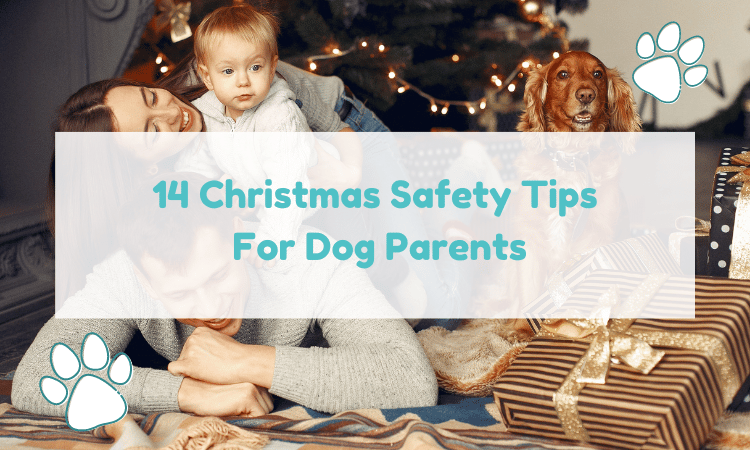Many say, “It’s the most wonderful time of the year”, and it can be extra special for parents of furbabies. My pups love sharing in the seasonal celebrations. They act excited when we help them open their gifts and stockings and exuberantly welcome guests in our home. It’s fun to include our pets, but we need to be aware that there are some potential risks during the holidays.
When it comes to the season, what’s good for the goose isn’t always good for the gander. In other words, there are types of Christmas trappings including some ornaments, gift wraps, and trimmings that can be dangerous. There are also particular holiday plants and foods that are poisonous to dogs.
The good news is that you can enjoy a pet-safe holiday with a bit of planning. By mapping out your celebrations and deciding your menu and decorations in advance, you and your four-footed friend can share the festivities with confidence.
Below, we’ll share tips to help you plan a pet-safe holiday.
Table of Contents
Human Foods That Are Toxic for Dogs
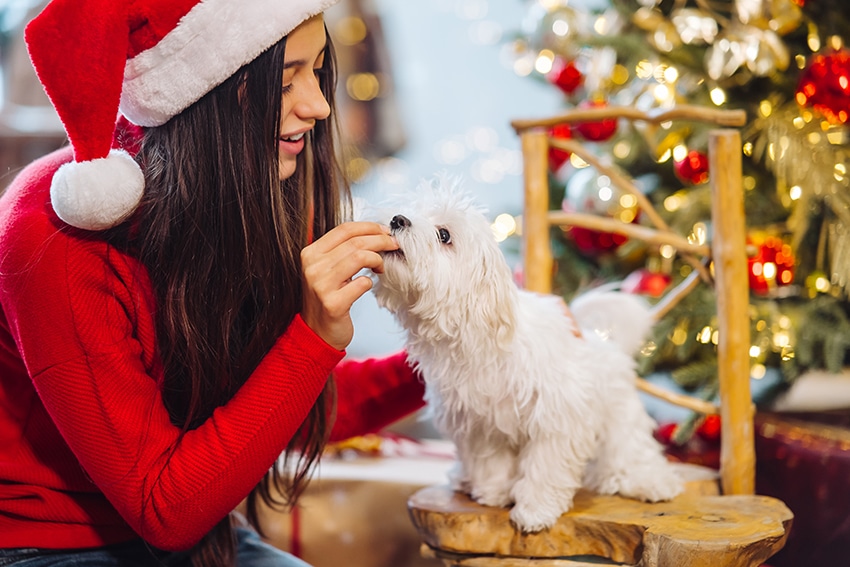
Pups have a way of looking longingly at you when you’re enjoying a special treat. It’s so tempting to share your tidbit, but is it wise? Your dog’s food is specially formulated to give him a balanced diet, so too many goodies can tip the scale the wrong way. Sure, small tastes usually are ok, but in the case of some foods, even a little bit can be dangerous. Below are examples of dangerous treats or ingredients that you may encounter during the holidays.
Alcohol
Alcohol is poisonous and can damage the liver, depress the central nervous system, and depress the breathing rate in both people and dogs. Larger doses can affect coordination, cause vomiting and diarrhea, and ultimately cause coma and death.
Most humans can handle moderate quantities of spirits. However, canines usually weigh less and have a lower tolerance, so they’re more readily affected by small amounts. That’s why you should never offer your furbaby a taste of your alcoholic beverage (and that includes Christmas liqueurs).
Macadamia Nuts
Before you offer your pooch a piece of a macadamia nut cookie or similar treat, think twice. Although they’re not usually deadly, this food may cause unpleasant effects like fever, muscle tremors, weakness, and vomiting.
Raisins
Grapes, currants, and raisins can be fatally poisonous for some dogs. For susceptible pups, they cause kidney failure with symptoms such as vomiting, lethargy, and loss of appetite usually appearing within 24 hours of ingestion. At this time, we don’t know what causes the toxicity, and why it only affects some animals. So stay on the safe side and keep anything with these fruits away from Fido.
Onion, Chives, and Garlic
Popular in many holiday foods, onions, chives, and garlic can cause anemia in some dogs. These herbs damage red blood cells and may also induce drooling, nausea, vomiting, and diarrhea. The severity of symptoms usually depends on how much the pooch ingests.
Nutmeg
Another common holiday spice is nutmeg. It’s often used as a topper on eggnog and special desserts. Large doses of this ingredient can cause hallucinations, stomach cramps, and seizures in dogs. Store your spices out of reach of your special pal.
Chocolate
Chocolate contains a stimulant called theobromine which is toxic to dogs. Targeting the circulatory system, the substance can trigger a rapid heart rate and may cause an irregular rhythm. Other side effects include nausea, diarrhea, vomiting, and polyuria (increased urine output). One of the reasons that chocolate is so dangerous for canines is that their systems take longer to break down the theobromine than human bodies.
The most toxic form of chocolate is dark chocolate because it has more cocoa, which is the source of the stimulant. Milk chocolate has a lower concentration of the substance, and white chocolate has no cocoa. However, the fat and sugar found in white chocolate is not a healthy choice for your pup.
Caffeine
Like the theobromine in chocolate, caffeine is a stimulant that’s toxic for dogs. Many holiday treats and desserts may include coffee, tea, or chocolate, and each of these ingredients has caffeine. Keep them away from your pooch.
Xylitol
The sugar substitute, Xylitol, is also a dangerous substance for dogs. Some of your holiday baked goods, sugarless candy, some brands of peanut butter, and other treats may contain this chemical. If a pooch ingests food that contains xylitol, it can cause liver damage, dangerous drops in blood sugar levels, seizures, and death.
Keep any candy, chewing gum, or other items that include xylitol in the ingredients away from your furry friend. Avoid leaving these tiny treats in jacket pockets or purses that may be accessible to your pal. You should also read the label whenever you buy peanut butter and avoid any brands that contain xylitol.
Eggnog
My husband practically salivates for eggnog during the holidays. This special treat contains many rich ingredients such as raw egg, alcohol, sugar, and fat that are unhealthy for your furbaby. If you choose to indulge in the beverage, don’t share it with Fido.
Dairy Products
After weaning, your pup’s digestive system changes to better process solid foods. So, when you offer dairy products, it can cause an upset. Some pooches also have an allergy to cow’s milk. Offering treats that are loaded with dairy ingredients like milk, cheese, or butter can trigger allergic reactions or a digestive upset. Resist sharing these goodies with your four-footed friend.
Ham and Bacon
Dishes with pork, particularly ham and bacon, are fat-laden, and they may have harmful preservatives. If you think anyone in the family wants to sneak a little taste to your canine companions, stop them. Feeding these foods can trigger pancreatitis.
Salt
During the holidays, many of our favorite dishes contain high levels of salt for flavoring and preservation. A heavy dose of this seasoning can cause your pooch to drink and pee a lot. Beyond that, if your special pal has underlying heart or kidney disease, a heavy salt load can put added stress on their body systems and make them very sick.
Poisonous Christmas Plants
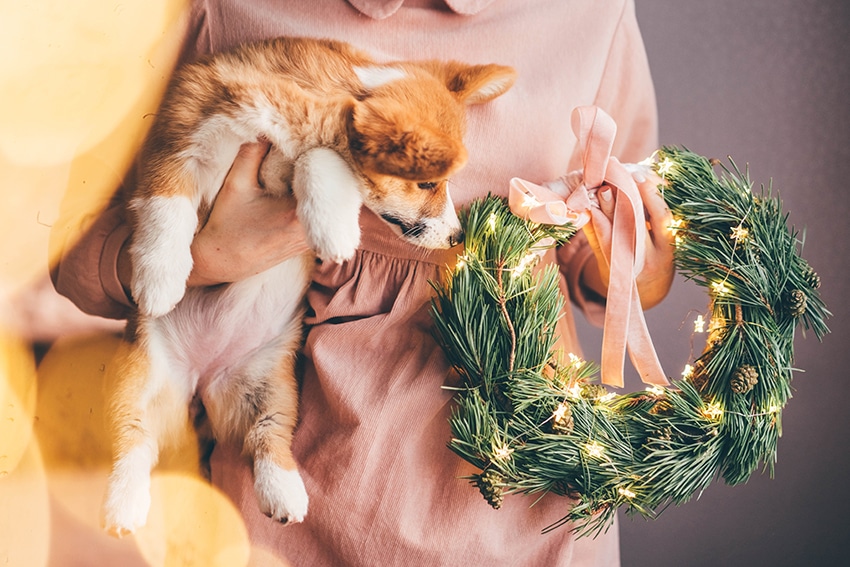
Traditional Christmas decorations frequently include some colorful plants. Some may be mildly toxic to pets and cause irritations without being life-threatening, while others can be deadly. For your pup’s safety, it’s best to avoid bringing foliage that’s toxic or irritating to Fido into the home. Even mildly poisonous varieties can cause serious illness if your pooch eats large quantities.
Poinsettias are attractive and popular plants that grace many households at Christmastime. They’ve been traditionally thought of as dangerous for any pets. However, recent evidence suggests that they may be only irritating or mildly toxic to dogs. Your pooch would have to ingest a large number of leaves to get sick. Mistletoe and holly are more toxic.
Holly poses two risks. First, it contains theobromine and another poison that can cause abdominal pain, vomiting, diarrhea, and drooling. Large enough quantities may lead to seizures and death. The second danger is from the spiny leaves. If your pooch eats them, they can cause mechanical injuries. The toxin is throughout the plant but most concentrated in the bright, red berries.
Mistletoe berries are moderately poisonous to dogs. They have multiple toxins that may trigger breathing difficulties, a plummet in blood pressure, and abnormal behavior due to hallucinations. As with holly, a large enough dose can cause seizures and death.
English Ivy makes an attractive decoration during the holidays, but it’s toxic for people and their pups. For humans, the greatest risk is skin irritation and blisters from contacting the leaves. However, if your furbaby decides to snack on the leaves and ingests a significant quantity, he may experience digestive upset, abdominal pain and burning, breathing difficulties, hallucinations, and seizures.
Yew is a highly toxic evergreen. Although it may be tempting to use in your festive decorations, this one is best left out of your plans. The plant contains poisons called taxines which can cause a dangerously slow heartbeat soon after ingestion. Other symptoms of yew toxicity include trembling, incoordination, diarrhea, convulsions, difficulty breathing, cardiac failure, and coma.
Christmas Cactus grace many homes with colorful flowers over the holiday season. Good news! These plants are not toxic to humans or canines. Feel free to display a few as part of your festive decor.
The Christmas Rose features delicate white or pale pink flowers that resemble roses. While they make a delightful holiday plant, they are moderately toxic to your pets. The severity of the symptoms depends on the amount of the plant that your pooch eats but can include mouth and throat irritation, abdominal pain, a depressed heartbeat, nausea, diarrhea, vomiting, depression, and weakness.
Christmas Trees and Greenery are a central part of the season. We’ll discuss Christmas trees below. If you like to use live greens such as pine or cedar boughs in your displays, you’re probably safe. Evergreens are mildly toxic, but most dogs won’t attempt to gnaw on the prickly needles or branches. However, if your pooch happens to ingest some needles, they can agitate or injure the gastrointestinal system. Some varieties of conifer, such as cedars, have oils that may irritate the skin.
Even though you may enjoy including these plants in your holiday decorations, it may not be worth the risk. Rather than take chances that your pup could ingest something that gives him an upset tummy or worse, avoid bringing them into your home.
Make Your Tree Dog-Proof
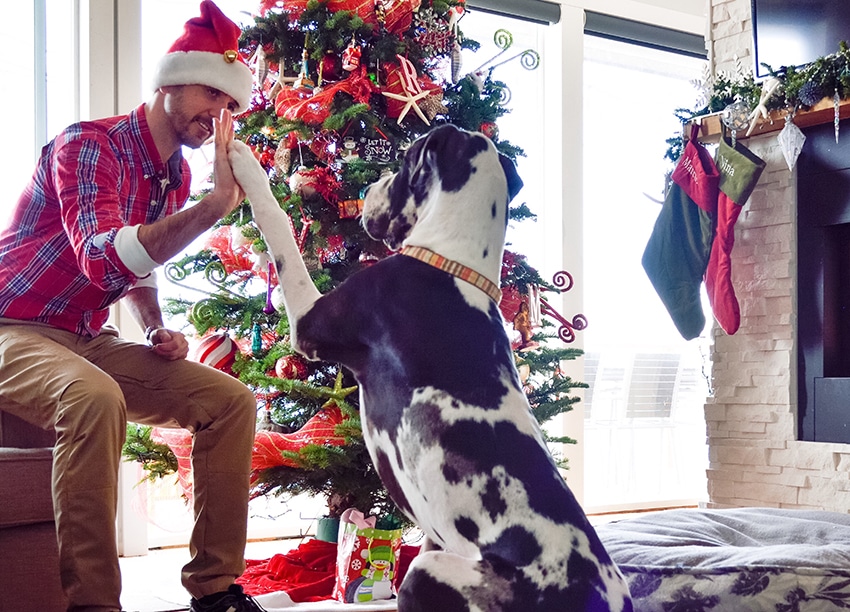
A Christmas centerpiece in many homes is the tree. This decoration can pose some risks for your furbaby. Here are some things to consider when selecting the best conifer for your household.
Decide Between Real or Artificial
A fresh pine adds a special aroma to your home, but is it the right choice for your pooch? A live tree may harbor molds that can trigger allergies in some pups and their owners. If you choose a fir for your decoration, how will you know it’s safe?
Especially if this is the first time you’re introducing your furbaby to a living tree, think about running a little experiment before you haul the conifer into the house. Take a branch or other sample of the pine you selected and bring it home. Let Fido investigate it while you’re looking on. If you don’t see any adverse reactions after a few days, you can probably safely set up the tree.
If your four-footed friend reacts, take the bough away ASAP. Clean your pup’s face and the area where you had the pine sample. For your pal’s safety, go artificial.
Setting-Up and Securing the Tree
Once you decide whether you’ll have a live or artificial tree, you need to plan where you will set it up. Having the right location can help keep your pooch safe.
One way to reduce the risk for Fido is by purchasing a smaller tree that you can display on a table and out of your pup’s reach. If you have a full-size pine, try setting it up in a corner to reduce your pal’s access. You can also wire the top to a stair banister or curtain rod to prevent your furbaby from knocking it over.
For live trees, make sure that you wrap the base and stand with plastic wrap. This will discourage your pooch from trying to lap up the water. Sometimes fertilizers and other toxic chemicals leach from the trunk into the basin.
When you decorate your conifer, avoid hanging ornaments on the bottom branches where they’re more tempting for your furbaby. Invest in pet-safe, shatter-proof decorations that are made of plastic or resin. Remember to tuck your lights into the branches and hide the cords by keeping them in the back of the tree and running any exposed length under or behind furniture. That way, your four-footed friend won’t be tempted to chew on them and get a shock.
Beware of Overindulgence
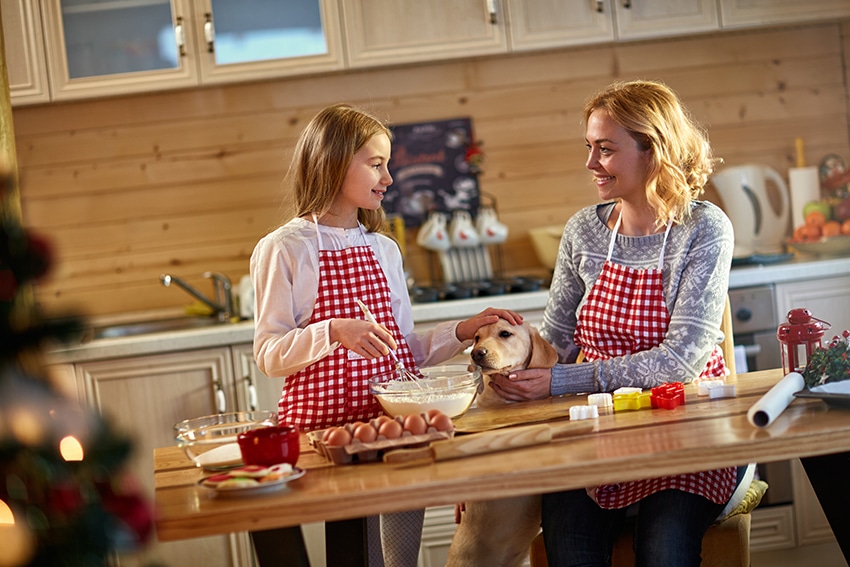
We, humans, enjoy sharing our holiday treats with our canine friends… Just a little won’t hurt, right? That depends on how many “little bits” we’re talking about. Remember, our furbabies don’t weigh as much as we do, so what seems like a tiny quantity can be too much for their systems.
When we go to far spoiling our dogs with our fatty leftovers such as ham, we can make them sick. They may experience an upset stomach, diarrhea, vomiting, or pancreatitis. Usually, the pancreas works with the intestines to digest food. But when it’s overwhelmed with fat, it becomes inflamed and can cause life-threatening illness.
Remember to keep leftover treats tiny, and keep feeding your furbaby a normal, balanced diet. Instruct your guests to avoid giving treats or leftovers to your pooch. If you have a master beggar, consider confining him to another room or his crate during the meal. You have to be the strong one for your pooch. After all, what self-respecting dog would say, no to a tasty treat?
Keep Table Decorations Dog-Safe
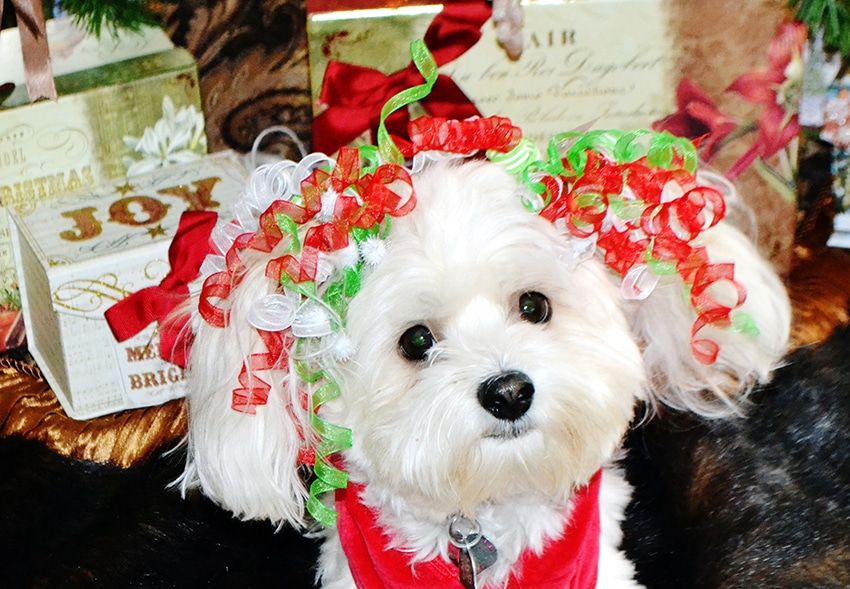
If you use brightly colored plant centerpieces, make sure the greenery is safe for your pooch. You may choose to go with artificial foliage. If that’s the case, check to make sure there aren’t any parts that come off easily and can become a choking hazard.
Another popular holiday decoration involves potpourri. Always research the product carefully. Find out what plants and oils are used in the mixture. Some ingredients can be dangerous or poisonous to dogs.
What about candles, you ask? Canines sometimes accidentally knock over candles, and that can create a fire risk. For a wonderful alternative, invest in battery-powered candles. Their flickering light is beautiful and safe.
Practice Fire Safety
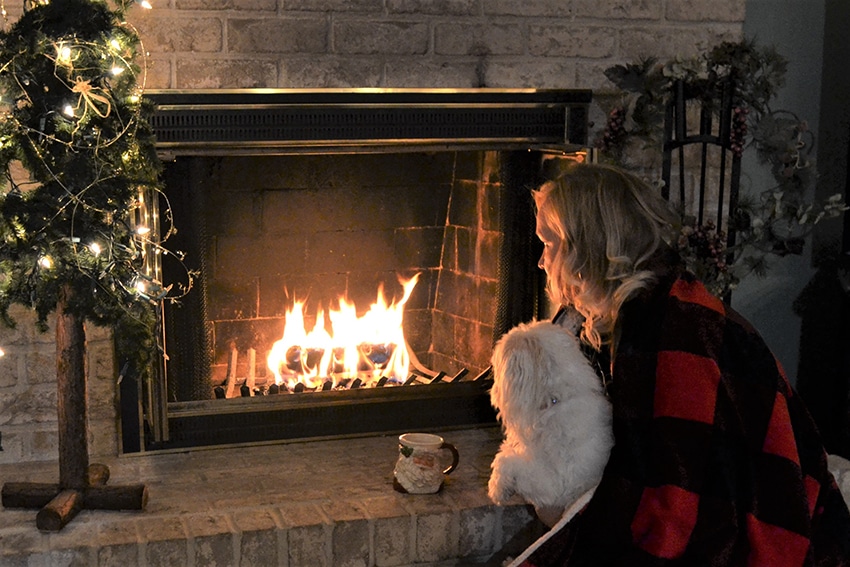
Now that we’ve mentioned candles, let’s talk fire safety. About 40,000 pets die in house fires each year, and around 1,000 of those flames are started by pets. Some ways that you can minimize the chances that your home becomes a statistic include:
- Extinguish burning candles and other open flames when you’re not around. Better yet, invest in LED candles.
- Keep loose wires and cords covered and out of reach. Check for any frayed wires and replace or repair them before they ignite an unwanted flame.
- Check your smoke detectors at least annually, and consider investing in a monitored smoke alarm. You should have one or more detectors on each floor in your home.
- Have a safety plan in place for emergencies. Know your floorplan and possible exits to safety. Arrange a place to meet with family members after you evacuate.
- Locate leashes by the front door or other designated emergency exits.
- Alert emergency crews about your pets by placing a pet evacuation alert sticker on your front door or window.
Don’t Leave Goodies Unattended
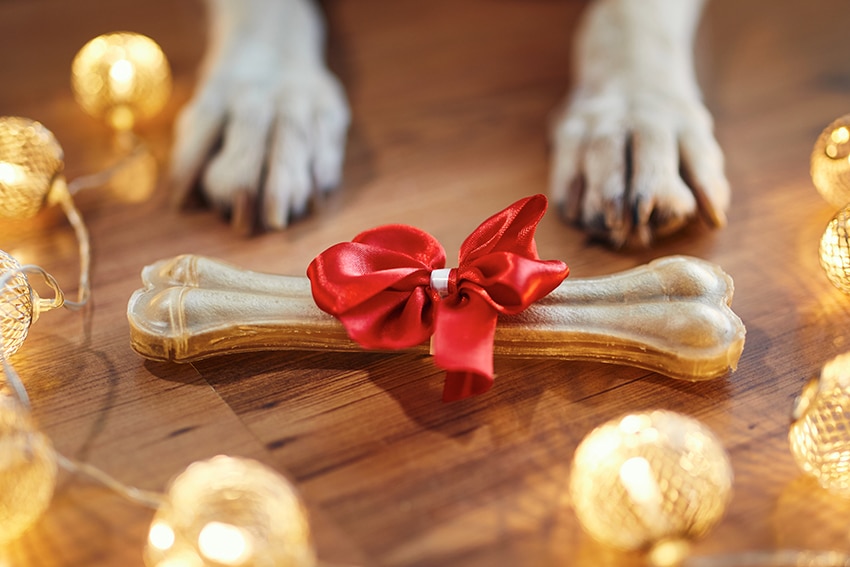
Roasted turkey, apple pie, freshly baked dinner rolls, and other holiday treats are tantalizing to man and beast alike. Don’t leave them out on the counter where your pup can reach. If they snatch your goodies, you’ll not only be out some dinner, but your pooch could also get sick. Turkey bones can splinter or get stuck in the esophagus, and the fatty skin can trigger a bout of pancreatitis. Protect your furbaby by never leaving tempting foods unattended.
Offer a Safe Place During Christmas Gatherings
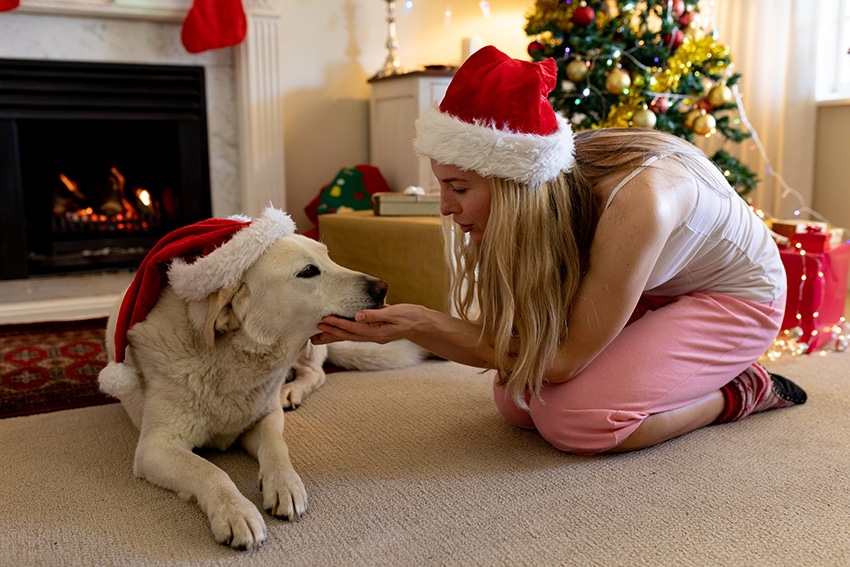
Unless you have a social pooch, parties and drop-ins can be overwhelming or downright terrifying for your dog. All the new faces and additional hubbub can be scary for some pets. Give Fido a private room or safe place where he can retreat when the activity is too much for his sensibilities. Amid the holiday bustle, strive to maintain a healthy diet and routine for your furbaby. Regular meals and exercise will help him feel more secure.
Gift Safety
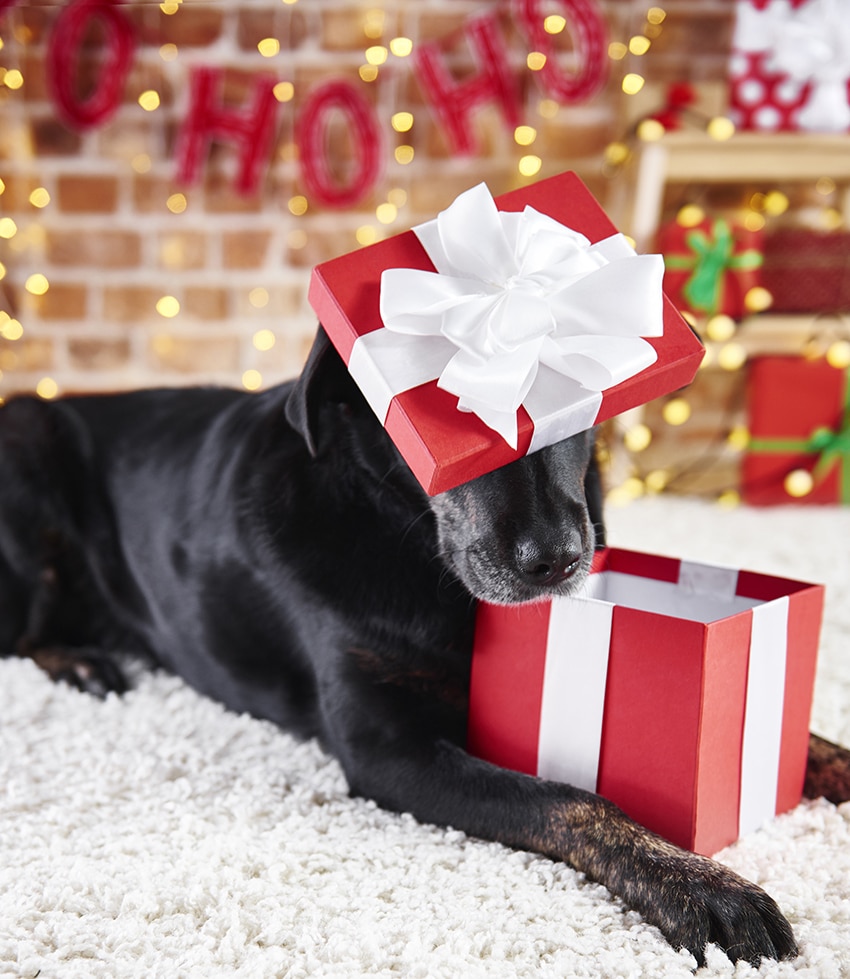
These days, many of the gifts we select for kids and adults alike require batteries which can be a serious health hazard for curious canines. If Fido ingests a battery, it may cause an obstruction, burn his gut, or give him an upset stomach. Toys may also have removable parts that are small enough to eat. These pieces may damage the intestines or cause a blockage. Keep toys and gadgets out of your pet’s reach to keep him safe.
Christmas Day Safety
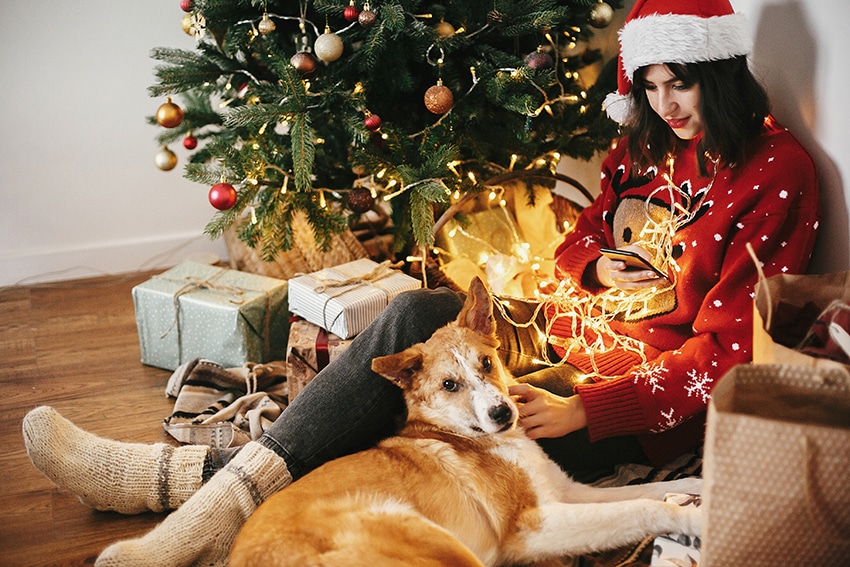
Who doesn’t love gathering around the tree to unwrap gifts? Depending on your pup, this event can be overly exciting or tempting. For Fido’s safety, you may not want to put the gifts under the tree before the big day. That way he won’t be tempted to tear into the packages and swallow something harmful.
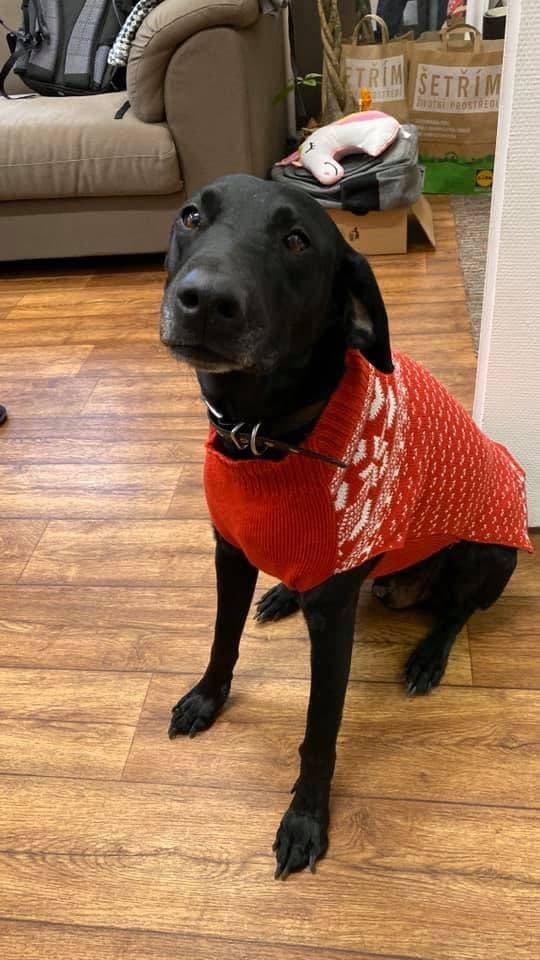
If your pooch gets overstimulated by the unwrapping activities, spread the activities out. Open a portion of the gifts and take a break doing something else. Then you can return to unveil more treats for everyone. Our family opens packages with our pups to share the fun. We use a stocking to avoid string and ribbons on their gifts because these items could cause obstructions if our furry friends swallowed them. When we open gifts for human family members, we quickly remove wrapping paper and bows to keep them out of our dogs’ reach.
In addition to gift opening and other Christmas day festivities, be sure to schedule some downtime for your pooch. Spend parts of your day quietly by reading a book or snuggling on the couch to watch a favorite holiday classic. These periods of respite will help your special friend relax and feel secure.
Christmas Dinner
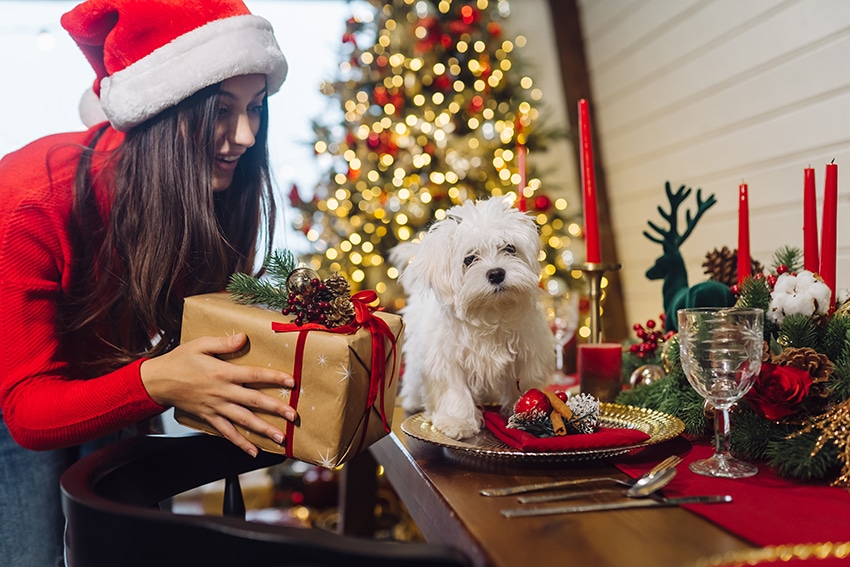
If you want to share some of your Christmas Day dinner with your furbaby, you can offer lean portions of cooked meat such as turkey. Remember to remove all the bones. Avoid giving your pal any sauces, stuffing, or sweet treats. Christmas candies and desserts should be stored out of reach when it’s unattended. Even if it doesn’t have dangerous ingredients, the rich foods aren’t healthy for your pooch.
Key Rules for Outdoor Safety

Holiday and winter safety concerns for Fido don’t stop at your threshold. There are potential hazards that you need to consider around your property and neighborhood so that you can help your furbaby stay safe.
Light and laser displays should be properly insulated to prevent electrical shock. Make sure you bury cords or tape them to the wall to prevent your pal from chewing on or getting tangled in the wires.
Yard ornaments need to be out of reach of your pooch. Low hanging items may contain toxic materials, or they could lead to gastrointestinal obstruction if eaten.
Winter walks are invigorating, but they have their risks. Frozen ground can be hard on the paws, and icy surfaces are slippery. Ice melt salts may contain irritating substances. Remember to clean your pal’s feet after walks with a damp towel, baby wipes, or a paw washer.
Antifreeze poisoning can happen at any time of year, but the smell of this chemical may be more attractive in frigid weather. Always handle antifreeze with care and avoid spilling any on the ground. Store bottles out of reach. Even a small amount can be fatal or severely debilitating.
Keep a collar with current ID tags on your furbaby at all times. The holidays may provide more opportunities for Fido to slip out the door when you’re entertaining guests or signing for packages. Using proper identification and can help you find your pooch should he become lost. As an extra security measure, consider microchipping your furbaby.
Plan Ahead
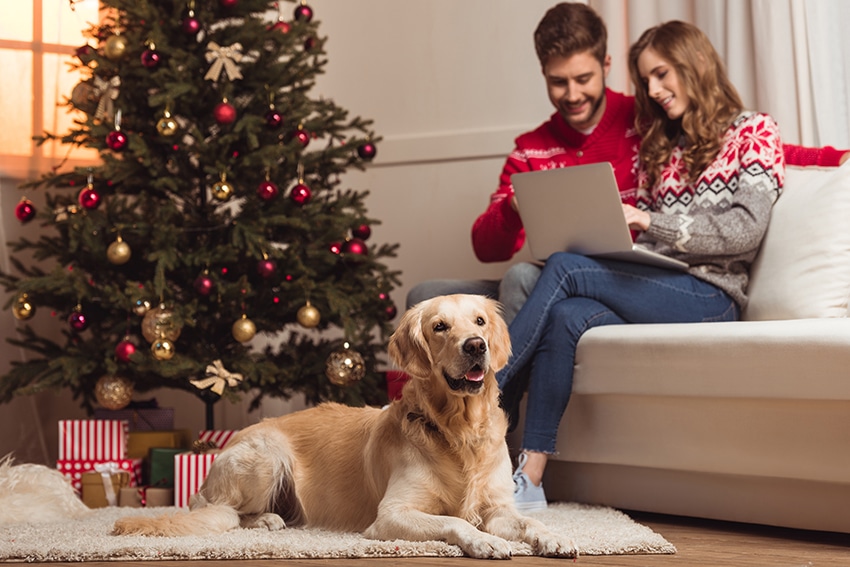
If your holidays include travel or entertaining, be prepared for unexpected events.
When you travel: If you’re boarding your pooch or having a dog sitter, make sure you have extra food and treats to cover travel delays. Provide contact information for yourself and your veterinarian. If Fido gets any medications, make sure you’re well-stocked and provide a list of all meds and doses to his caregiver.
Traveling with your pup: Pack your pet’s essentials such as food, treats, toys, and any meds. Plan your trip to include regular rest stops for Fido to stretch his legs and relieve himself.
Entertaining: Decide in advance how you will handle your pooch. Make sure he has a safe place where he can escape from the crowds. Have a contact list handy that includes the local emergency vet and any clinics that will be open on Christmas. You’ll also want to make sure that you have basic first-aid supplies for your furbaby. That way, you’ll be better prepared for unexpected events.
Managing Gift Wrapping
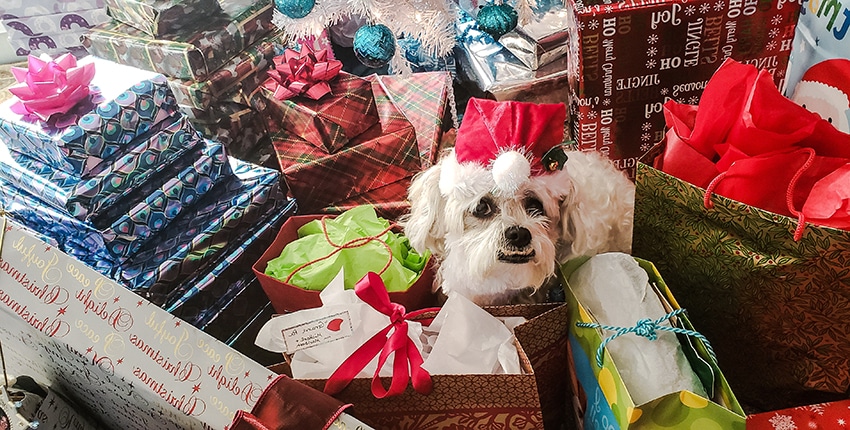
Bright crinkly paper, ribbons, and bows can look like fun playthings to some dogs, but they can cause intestinal blocks if your pooch eats them. Keep pets away when you’re wrapping gifts. Rember also to store scissors in a safe place and don’t leave them on low tables or the floor. The sharp points and edges could injure a curious pup.
Once you wrap your gifts, consider storing them in a closet until Christmas day. Practice caution when leaving packages under the tree, especially if they’re adorned with ribbons or bows.
Have a Safe and Happy Holiday Season!
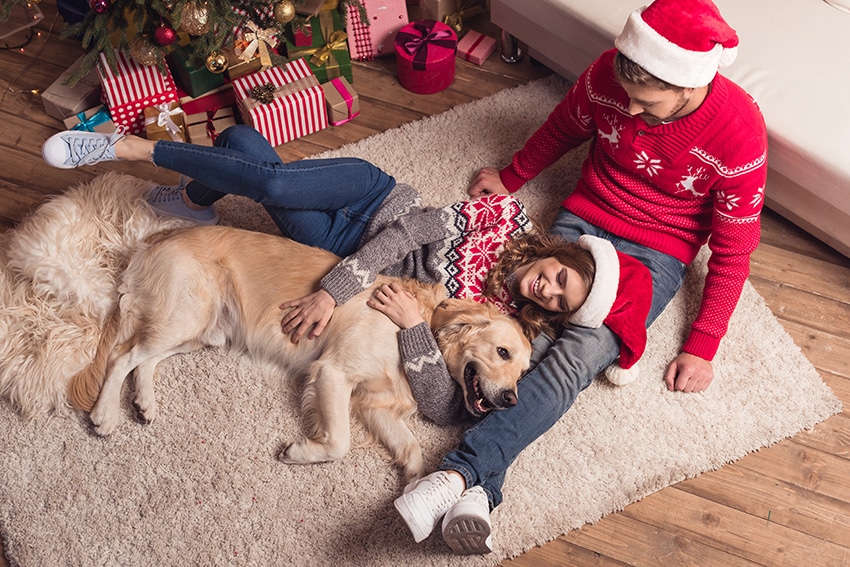
Pet parents love to share the holidays with their furry friends, and they want to keep them safe. Following these tips can help you have a joyful season and protect your furbaby. Merry Christmas to all!

